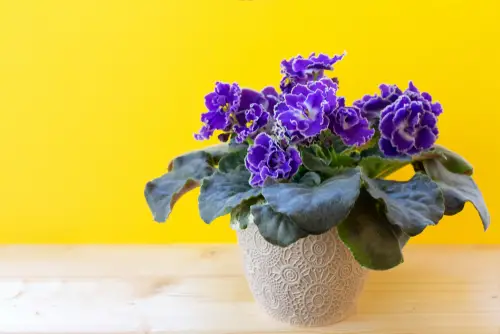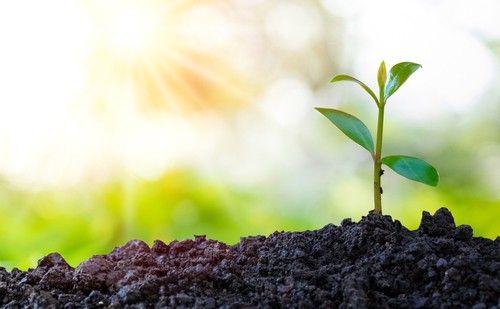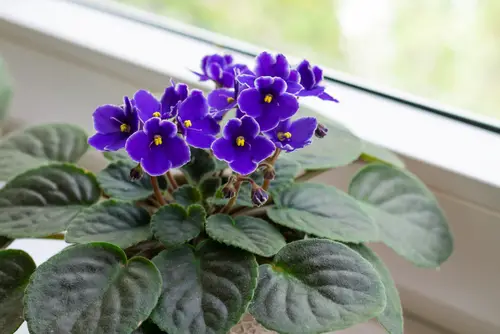African violets are popular houseplants known for their beautiful flowers and easy care. However, if you notice your African violet leaves turning brown, it can be a cause for concern.
Brown leaves can be a sign of several issues, from natural aging to poor care practices. In this article, we will explore the common causes of brown leaves in African violets, how to prevent them, and what to do if your plant is already suffering.
Understanding African violets is key to diagnosing and preventing brown leaves. These plants require bright, indirect light, high humidity, and well-draining soil to thrive.
Overwatering, underwatering, low humidity, and poor air circulation can all contribute to brown leaves. Additionally, African violets are sensitive to extreme temperatures and drafts, which can also cause leaf damage. By following proper care practices, you can prevent many of these issues and keep your African violet healthy and vibrant.
If you notice brown leaves on your African violet, it is important to diagnose the issue promptly. Brown leaves can be a sign of several problems, from natural aging to pests and diseases. By examining the plant and identifying any other symptoms, you can determine the cause of the brown leaves and take appropriate action.
In some cases, repotting the plant or adjusting its care regimen may be necessary to help it recover. With proper care and attention, your African violet can continue to thrive and bring beauty to your home.
Key Takeaways
- African violets require bright, indirect light, high humidity, and well-draining soil to thrive.
- Brown leaves can be a sign of several issues, from natural aging to poor care practices.
- Proper diagnosis and care can help prevent and treat brown leaves in African violets.
Understand the care tips of these other popular plants:
- Why Are My Zinnia Leaves Turning Brown?
- Staghorn Fern Leaves Turning Brown
- Strawberry Plant Turning Brown?
Understanding African Violets

African violets are a popular houseplant among growers due to their delicate yet hardy nature. These plants are known for their vibrant, colorful blooms that can last for several months.
African violet plants are native to Tanzania and are a part of the Gesneriaceae family. They are named after their violet-like flowers and are available in a wide range of colors, including pink, purple, blue, and white.
African violets are a popular choice for indoor gardening because they are relatively easy to care for. However, they are also known for being delicate and require specific growing conditions to thrive.
These plants prefer moderate temperatures, bright but indirect light, and well-draining soil. They are also sensitive to overwatering and can develop root rot if their soil is too wet.
One of the most common issues that African violet growers face is brown leaves. Brown leaves can be caused by a variety of factors, including overwatering, underwatering, direct sunlight exposure, and nutrient deficiencies.
African violets are sensitive to changes in their environment and can quickly show signs of stress if their growing conditions are not ideal. In order to keep African violets healthy and vibrant, it is important to provide them with the right growing conditions.
This includes providing them with a well-draining soil mix, watering them only when the soil is dry to the touch, and placing them in a location with bright but indirect light. With proper care, African violets can thrive and produce beautiful blooms for years to come.
African Violet Leaves Turning Brown – 6 Common Problems
African violets are delicate plants that require specific care to thrive. If you notice your African violet’s leaves turning brown, it’s a sign that something is wrong. Here are the most common causes of brown leaves in African violets:
1. Inadequate Watering
African violets require consistent, gentle watering. Over-watering or under-watering can cause the leaves to turn brown. If the soil is too wet, the roots can rot, causing the leaves to turn brown and wilt. On the other hand, if the soil is too dry, the plant will not be able to absorb enough water, causing the leaves to dry out and turn brown.
2. Excessive Sunlight

African violets prefer bright, indirect sunlight. Direct sunlight can cause the leaves to burn and turn brown. If your African violet is getting too much sunlight, move it to a shadier location.
3. Temperature Changes
African violets are sensitive to temperature changes. Cold drafts or sudden temperature drops can cause the leaves to turn brown. Keep your African violet away from windows and doors that may let in cold drafts.
4. Improper Fertilization
Over-fertilization or under-fertilization can cause the leaves to turn brown. Use a balanced fertilizer specifically designed for African violets and follow the instructions carefully.
5. Pest Infestation
Pests such as cyclamen mites and spider mites can cause discoloration and brown spots on African violet leaves. Regularly check your plant for signs of infestation and treat promptly if necessary.
6. Natural Aging Process
As African violet leaves age, they naturally turn brown and dry out. This is a normal part of the aging process and is not a cause for concern.
Preventive Measures and Care
1. Proper Watering
Proper watering is crucial to prevent African violet leaves from turning brown. Over-watering or under-watering can both cause damage to the plant. It is recommended to water African violets from the bottom to avoid waterlogging the soil and causing root rot.
Bottom-watering allows the plant to take up water as needed, and excess water can be drained away. A moisture meter can be used to determine when the soil is dry enough to water again.
2. Appropriate Lighting
African violets prefer indirect or filtered light. Direct sunlight can cause the leaves to burn and turn brown. If the plant is not receiving enough light, it may become leggy and the leaves may turn yellow or brown. Grow lights can be used to supplement natural light, but it is important to choose the right light conditions for the plant.
3. Temperature Management

African violets prefer temperatures between 65-75°F (18-24°C). Temperatures outside of this range can cause the leaves to turn brown. Cold drafts can also damage the plant, so it is important to keep it away from windows and doors during the colder months.
4. Correct Fertilization
African violets require a balanced fertilizer that is urea-free. Over-fertilization or using the wrong type of fertilizer can cause the leaves to turn brown. It is recommended to fertilize African violets every 2-4 weeks during the growing season, and less frequently during the dormant season.
5. Pest Control
Pests such as spider mites, mealybugs, and thrips can damage African violet leaves and cause them to turn brown. Regular inspection and treatment with an appropriate insecticide can prevent pest infestations. It is important to follow the manufacturer’s instructions when using any chemical treatments.
Diagnosis and Recovery
Identifying the Problem
If your African violet leaves are turning brown, it could be due to a number of reasons. One common cause is overwatering, which can lead to root rot and brown, crispy leaves.
Another culprit could be too much direct sunlight, which can cause leaf spotting and brown spots on the leaves. African violets are also sensitive to temperature changes, so if they are exposed to cold drafts or hot, dry air, their leaves can turn brown.
To accurately diagnose the problem, carefully examine the plant and its environment. Check the soil for moisture levels, and ensure that the plant is not getting too much or too little light.
Look for any signs of pests or disease, such as spider mites or fungal leaf spots. Once you have identified the cause of the brown leaves, you can take steps to revive your plant and promote new growth.
Reviving Your Plant

To recover a healthy plant with new growth, it is important to remove any brown leaves or affected foliage. This will prevent the spread of disease and allow the plant to focus its energy on new growth.
Use a pair of clean, sharp scissors to carefully trim away any brown or crispy leaves, making sure to cut them as close to the base of the stem as possible.
Next, adjust the plant’s environment to promote healthy growth. African violets prefer indirect sunlight and humid conditions, so consider moving the plant to a location with bright, filtered light and misting the leaves regularly. Make sure the soil is well-draining and not too wet, as overwatering can lead to root rot and brown leaves.
If you suspect that the brown leaves are due to a nutrient deficiency, consider fertilizing the plant with a balanced fertilizer designed for African violets. Be sure to follow the manufacturer’s instructions carefully, as over-fertilizing can lead to brown spots and leaf spotting.
With proper care and attention, your African violet can recover from brown leaves and thrive once again. By identifying the problem and taking steps to promote healthy growth, you can enjoy the beauty of these delicate plants for years to come.
Soil and Repotting
Choosing the Right Soil
African violets require well-draining soil that retains moisture without becoming waterlogged. When choosing soil for African violets, it is important to select a mix that is specifically designed for these plants. A good soil mix will contain peat moss, perlite, and other ingredients that promote good drainage and aeration.
Peat moss is an organic material that helps to retain moisture in the soil, while perlite is a lightweight, porous material that improves drainage. A good soil mix for African violets should contain a high percentage of peat moss and perlite.
The Repotting Process
African violets should be repotted every 6 to 12 months to ensure that they have enough nutrients and room to grow. When repotting, it is important to use a pot that is slightly larger than the current one, as African violets prefer to be slightly root-bound.
To begin the repotting process, gently remove the plant from its current pot and shake off any excess soil. Inspect the roots for any signs of damage or disease, and trim away any dead or damaged roots.
Next, add a layer of fresh soil mix to the bottom of the new pot, and place the plant in the center. Fill in the space around the plant with fresh soil mix, making sure to gently press the soil down to remove any air pockets.
After repotting, water the plant thoroughly and allow excess water to drain away. It is important to avoid overwatering, as wet soil can lead to root rot and other soil issues.
Soil Issues and Salt Buildup
Over time, soil can become compacted and lose its ability to drain properly. When this happens, it is important to repot the plant in fresh soil mix to ensure that it has the nutrients and drainage it needs to thrive.
Another issue that can arise with African violet soil is salt buildup. This occurs when fertilizer salts accumulate in the soil over time, leading to brown leaves and other issues. To prevent salt buildup, it is important to flush the soil periodically with water to remove any excess salts.
Additional Resources

For those who want to learn more about caring for their African violets and preventing brown leaves, there are many resources available. These resources include online shops, Facebook groups, and African violet clubs.
Online shops such as African Violet Resource Center and Violet Barn offer a wide variety of African violets and supplies, as well as helpful information on their websites. These shops are a great resource for those who want to purchase new plants or supplies, or who want to learn more about African violet care.
Facebook groups, such as African Violet Lovers and African Violet Society of America, are a great way to connect with other houseplant lovers and share tips and advice. These groups are also a great place to ask questions and get advice from experienced African violet growers.
For those who want to take their African violet care to the next level, joining an African violet club can be a rewarding hobby. These clubs often offer meetings, shows, and other events where members can learn more about African violet care and connect with other enthusiasts.
The African Violet Society of America is a great place to start for those who are interested in joining a club.
Finally, for those who are new to African violet care, a beginner-friendly guide can be a great resource. The Complete Guide to Growing Beautiful African Violets by Lyndon Lyon Greenhouses is a great resource for beginners, offering clear and concise information on all aspects of African violet care.
Frequently Asked Questions
What causes brown spots on African violet leaves?
Brown spots on African violet leaves can be caused by several factors, including overwatering, underwatering, fungal infections, or pests. African violets are sensitive to water, and if the leaves are exposed to too much moisture, they can develop brown spots.
Additionally, fungal infections can cause brown spots on the leaves. It is important to identify the underlying cause of the brown spots to treat the problem effectively.
Why are the edges of my African violet leaves turning brown?
The edges of African violet leaves may turn brown due to several reasons, including over-fertilization, low humidity, or exposure to direct sunlight. Over-fertilization can cause the edges of the leaves to turn brown, as the plant may not be able to absorb all the nutrients.
Low humidity levels can also cause the edges of the leaves to dry out and turn brown. Lastly, exposure to direct sunlight can cause the leaves to burn and turn brown around the edges.
How do I prevent my African violet leaves from turning brown?
To prevent African violet leaves from turning brown, it is important to provide the plant with the right amount of water, light, and nutrients. The plant should be watered when the soil is dry to the touch, and the pot should have good drainage to prevent overwatering.
African violets prefer bright, indirect light, and should not be exposed to direct sunlight. Lastly, the plant should be fertilized with a balanced fertilizer every four to six weeks.
What is causing my African violet leaves to turn yellow?
African violet leaves may turn yellow due to several reasons, including overwatering, underwatering, low light, or nutrient deficiencies. Overwatering can cause the leaves to turn yellow and eventually die, as the roots may become waterlogged and unable to absorb nutrients.
Underwatering can also cause the leaves to turn yellow and dry out. Low light levels can cause the leaves to lose their color and turn yellow, while nutrient deficiencies can cause the leaves to turn yellow and become stunted.
How can I fix brown leaves on my African violet?
To fix brown leaves on African violets, it is important to identify the underlying cause of the problem. If the leaves are turning brown due to overwatering, the plant should be watered less frequently.
If the leaves are turning brown due to low humidity, a humidifier can be used to increase the moisture levels around the plant. Additionally, if the leaves are turning brown due to pest infestations or fungal infections, appropriate treatments should be used to eliminate the problem.
Why are my African violet leaves curling and turning brown?
African violet leaves may curl and turn brown due to several reasons, including low humidity, over-fertilization, or exposure to direct sunlight. Low humidity levels can cause the leaves to curl and dry out, while over-fertilization can cause the leaves to curl and turn brown around the edges.
Lastly, exposure to direct sunlight can cause the leaves to curl and turn brown, as they may become burnt.

Hey, I’m Lisa and I’ve been an avid gardener for over 30 years. I love writing, talking and living in the garden! Feel free to connect with me on my socials below


